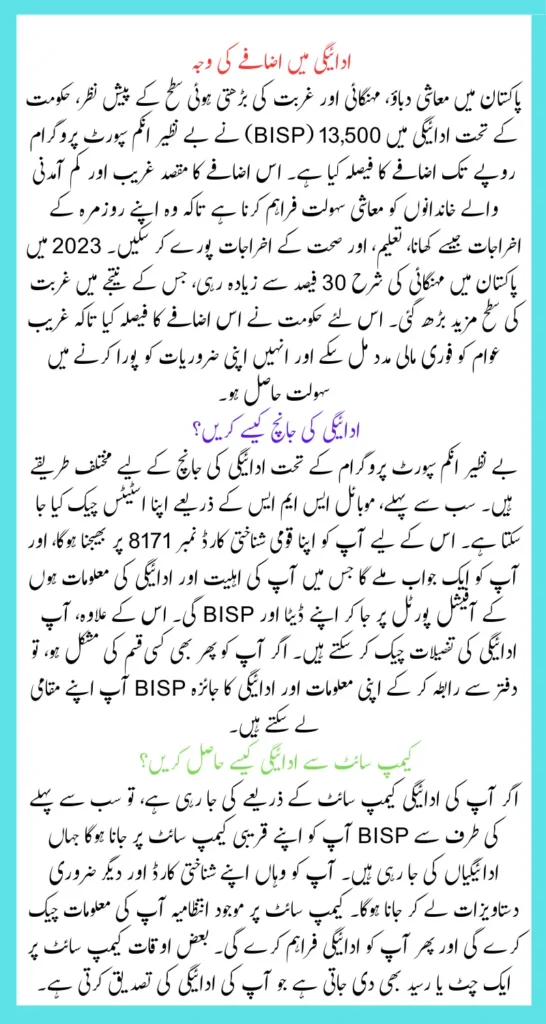BISP Quarterly Payment Increase 13500
BISP Quarterly Payment Increase 13500 The Benazir Income Support Program is one of the most significant social welfare schemes in Pakistan. Introduced in 2008 by the then-Prime Minister under the leadership of Pakistan, the program aims to provide financial assistance to the country’s most impoverished segments of society. As of January 2025, there is an exciting development that has caught the attention of millions of Pakistani citizens – a quarterly payment increase that will raise the disbursements to 13500 per recipient.
You Can Also Read: BISP 2025 New Installment 13500 Phase 1
BISP Quarterly Payment Increase 13500 Although this increase is a welcome relief for many struggling families, it also raises many questions regarding the program’s sustainability, its long-term impact on poverty alleviation, and its implications for Pakistan’s socio-economic landscape. In this article, we will explore all the essential details surrounding the upcoming increase, its importance, and the broader context of BISP’s role in social safety nets for the nation.

A Brief Introduction The Benazir Income Support Program
BISP Quarterly Payment Increase 13500 Before diving into the specifics of the increase in payments, it’s essential to understand the structure and objectives of the Benazir Income Support Program. The program was established with the primary objective of providing cash transfers to low-income families. These cash transfers are meant to help cover basic needs such as food, education, and healthcare.
Over the years, BISP has been expanded and restructured to reach more beneficiaries. As of 2023, over 7 million families are registered under the program. BISP is widely recognized for its efficiency in delivering support to the most vulnerable sectors of society, particularly rural women, who often suffer from limited access to resources and decision-making power.
BISP Quarterly Payment Increase 13500 The primary mechanism for distributing financial aid is through quarterly disbursements. Initially, the payments were smaller, but with inflation and the growing need for support, the amounts have increased incrementally over the years.
You Can Also Read: 8171 Web Portal 2025 Updated With New Installment 13500
Key Reasons For The Payment Increase to 13500
BISP Quarterly Payment Increase 13500 The increase in the quarterly payment to 13,500 PKR per recipient is part of the government’s strategy to provide enhanced financial support to vulnerable families. Here are the major reasons driving this decision:
Rising Inflation And Economic Pressures
In recent years, Pakistan has faced severe inflationary pressures. The cost of essential goods such as food, healthcare, and education has risen dramatically. In 2023, Pakistan’s inflation rate touched a historic high of over 30%, affecting millions of families who rely on social safety nets. The government’s decision to increase BISP payments is, therefore, a response to the escalating economic challenges faced by the poor.
Increased Poverty Levels
BISP Quarterly Payment Increase 13500 The economic disruptions caused by political instability, natural disasters, and the aftermath of the COVID-19 pandemic have pushed millions of people into poverty. According to the World Bank and Pakistan Bureau of Statistics, poverty levels in the country are expected to rise, making it more difficult for families to meet their basic needs. The quarterly payment increase is a direct effort to mitigate these rising poverty levels and provide immediate relief to the most vulnerable communities.
Commitment To Social Welfare
The Pakistani government, under the leadership of Prime Minister Shehbaz Sharif and other stakeholders, has consistently emphasized its commitment to strengthening social welfare programs. This increase in BISP payments reflects the country’s ongoing dedication to reducing income inequality and fostering inclusive economic growth.
Addressing The Growing Need For Support
Pakistan’s population is growing rapidly, and many families are finding it increasingly difficult to make ends meet. As the population grows, the demand for social assistance also increases. The payment increase will help address this expanding need, ensuring that more families can be helped through the system.
You Can Also Read: BISP Registration Check By CNIC 2025 For New Installment 13500
Political Strategy Ahead Of Elections
BISP Quarterly Payment Increase 13500 Another reason for the increase could be the political considerations ahead of Pakistan’s 2025 General Elections. Political parties often use social welfare programs to gain support from voters, especially among low-income groups. This boost in BISP payments could be seen as a move to strengthen the government’s position in the run-up to the elections, showing that the leadership is responsive to the needs of ordinary citizens.
How The Quarterly Payment Increase Will Work
BISP Quarterly Payment Increase 13500 As of January 2025, the quarterly disbursement per eligible family will increase to 13,500. Here’s how the payment mechanism is structured:
Eligibility Criteria
- BISP primarily targets low-income families, especially in rural areas. The Ehsaas Program plays a pivotal role in identifying eligible recipients.
- Families with incomes below a certain threshold, those without adequate access to healthcare, and those facing food insecurity are prioritized.
- Women are often the primary recipients, as they are disproportionately affected by poverty and lack of resources.
- Receiver must a belong to a poor family and has poverty score of less than 34%
- They don’t have land, business, or vehicle and have not traveled to a foreign country
Payment Schedule
- The quarterly payment will be disbursed in three installments: one at the beginning of the quarter and two smaller payments later in the cycle.
- Payments will be made via mobile banking, ATM cards, or cash distribution points depending on the recipient’s location and preferred method of receiving funds.
Increased Payment Benefits
- With the new increase, each eligible family will receive 4,500 PKR per month, compared to the previous figure of 3,000 PKR per month.
- The additional funds are expected to help families purchase essential food items, pay for school fees, and cover other household expenses.
Digitalization and Transparency
- The government is working towards increasing the transparency of the payment process by moving toward more digital payment systems.
- BISP recipients will be able to access their funds via bank accounts or digital wallets, reducing the risks of corruption or mismanagement of funds.
Socio-Economic Impact of the Payment Increase
BISP Quarterly Payment Increase 13500 The increase in BISP payments will undoubtedly have a substantial impact on Pakistan’s most marginalized populations. However, the effectiveness of this payment increase will depend on various factors:
You Can Also Read: Benazir Kafalat 2025 Registration For 13500 Via Mobile Van And Tehsil Office
Improved Standard of Living
The additional funds will likely improve the standard of living for millions of Pakistani families. While it may not be enough to lift them out of poverty entirely, it will certainly provide some relief, particularly in meeting the most basic needs.
Economic Multiplication
BISP Quarterly Payment Increase 13500 The increased payments will likely have a positive multiplier effect on the local economy. Low-income families tend to spend most, if not all, of their income on essential goods and services. As these families purchase more food, clothing, and other necessities, it boosts demand in local markets, supporting small businesses and creating economic activity in areas where it’s most needed.
Increased Access To Education And Healthcare
The additional income may enable families to send their children to school or access basic healthcare services, which are often unaffordable for low-income communities. With a steady income stream, more children might remain in school, and families might be able to visit doctors for regular check-ups and treatments.
Social Cohesion
The program also promotes social cohesion by providing support to the most vulnerable groups in society. It reduces the risk of alienation and social unrest by ensuring that people in dire need of financial support are not left behind.
You Can Also Read: Benazir Taleemi Wazaif Payment Released Today
Potential Challenges and Criticisms
BISP Quarterly Payment Increase 13500 While the increase in quarterly payments is a positive step, it is not without challenges. Some of the issues that need to be addressed include:
Sustainability of Funding
The Pakistani government is already facing a budget deficit and significant debt burdens. Questions arise regarding the long-term sustainability of the program. Will the government be able to continue increasing payments in the future? If inflation continues to rise, the increased payments may eventually lose their purchasing power.
Inflationary Impact
There is also the concern that the increase in payments may contribute to inflation if not matched by an increase in production or supply of goods. With more money in circulation, prices may rise, which could erode the effectiveness of the payment increase.
Administrative Efficiency
Ensuring that the payments reach the right beneficiaries is a critical issue. While the digitalization efforts have improved transparency, inefficiencies or corruption at local levels may undermine the impact of the program. The government must ensure robust oversight and effective delivery mechanisms.
Dependence on Aid
Another concern is that cash transfers may create a dependency culture, where people become reliant on government aid rather than seeking sustainable income sources. A balance must be struck between providing immediate relief and encouraging long-term solutions such as skills training, job creation, and entrepreneurship.
You Can Also Read: 8171 Web Portal 13500 Payment Status 2025
Conclusion Of BISP Quarterly Payment Increase 13500
BISP Quarterly Payment Increase 13500 The new decision of the BISP Program to increase the quarterly payment to 13500 in January 2025 is a significant move towards combating poverty and providing relief to millions of Pakistani families who are struggling in the face of economic challenges. While this increase is a much-needed intervention, the government must continue to monitor and adjust the program to ensure its long-term effectiveness.
BISP Quarterly Payment Increase 13500 At the same time, the increase in payments can be seen as part of Pakistan’s broader strategy to address systemic poverty, enhance social welfare, and reduce income inequality. As the country continues to face economic uncertainties, the BISP stands as a vital tool for supporting the nation’s most vulnerable populations. However, the government needs to balance short-term relief with sustainable development initiatives that promote economic independence and resilience for future generations.
You Can Also Read: CM Free Solar Panels Scheme Registration Closed
FAQS Of BISP Quarterly Payment Increase 13500
What is the Benazir Income Support Program?
The BISP is a social welfare initiative in Pakistan, launched in 2008 to provide financial assistance to low-income families, particularly those in rural areas. It aims to alleviate poverty and ensure access to basic needs like food, healthcare, and education.
Why has the government decided to increase the BISP payment to 13,500 PKR in January 2025?
The government has increased the BISP payment due to rising inflation, increased poverty levels, and the growing need for financial support among Pakistan’s vulnerable populations.
What are the eligibility criteria for BISP beneficiaries?
BISP primarily targets families with low incomes, especially those in rural areas, and women as the main recipients. To qualify, applicants must have a poverty score under 34%, no land, business, or vehicle, and must not have traveled abroad.
How will the increased payment benefit the recipients?
The increase in payments will help families meet essential needs such as food, healthcare, and education. It also has the potential to boost local economies through increased spending on goods and services.
What are the potential challenges of increasing BISP payments?
Challenges include ensuring the program’s sustainability, preventing inflationary effects, maintaining efficient distribution systems, and avoiding a dependency culture on government aid rather than fostering long-term solutions like skill-building and employment.
